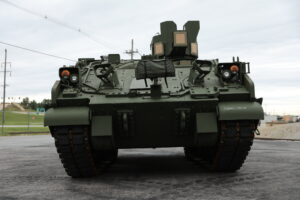Lockheed Martin [LMT] has received $72.8 million to continue work on the Army’s program to provide an integrated suite of signals intelligence, electronic warfare and cyber capabilities for brigade combat teams.
While the Terrestrial Layer System Brigade Combat Team (TLS BCT) program has focused on providing the SIGINT, EW and cyber suite to Stryker vehicles, the new award initiates Lockheed Martin’s work to bring the capability to Armored Multi-Purpose Vehicles (AMPV).

The Army’s Project Manager Electronic Warfare & Cyber (PM EW&C) announced the deal on April 12, which it said is split between one award to procure more TLS-BCT systems for Strykers and a second with funds to support the program’s operational demonstration later this year and system design work for AMPV.
After Lockheed Martin participated in a competitive first phase of TLS-BCT, the Army selected the company to continue developing the system and last July received a deal worth nearly $59 million to provide prototype systems for Strykers (Defense Daily, July 13 2022).
“TLS-BCT equips the new force structure in the Intelligence Collection Platoon and the EW Platoon that are organic to the Military Intelligence Company in the Brigade Combat Team and integrated on maneuver formation vehicle platforms,” Ken Strayer, head of the Army’s PM EW&C, said in a statement at the time of the July 2022 award. “The new integrated suite of signals intelligence, electronic warfare and cyberspace operations provides the warfighter with critical situational awareness of the enemy through detection, identification, location, exploitation, and disruption of enemy signals of interest.”
The new AMPV, built by BAE Systems, is the Army’s replacement for its legacy M113 armored personnel carriers.
The Army recently achieved the First Unit Equipped Milestone for AMPV, with BAE Systems now moving portions of its production work to other facilities to ensure its York, Pennsylvania manufacturing site has expanded capacity as the Army works toward annually delivering “a brigade and a half” worth of the vehicles within two years (Defense Daily, March 31).